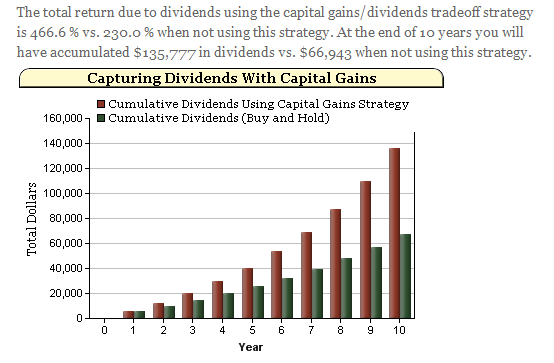When investing in Real Estate Investment Trusts (REITs) or Master Limited Partnerships (MLPs), investors are sometimes surprised by the hefty tax bill. REITs and MLPs are taxed at ordinary income tax rates if they are in taxable accounts, which takes a big bite out of the total return for many. But there is a way to get around this tax bill if an investor has capital losses he can use. I call this strategy dividends to capital gains conversion.
The idea is this: By taking dividends in the form of capital gains, and then offsetting those gains with capital losses you may have, you can pay an effective tax rate of 0%. Compare this to paying either the 15% rate for qualified dividends (for most people) or your top marginal income tax rate on REIT investments and MLPs.
So how does one go about converting dividends to capital gains? It takes some monitoring, but it could very well be worth your time. First let’s define the ex-dividend date for a stock:
The ex-dividend date is the day on which all shares bought and sold no longer come attached with the right to be paid the most recently declared dividend. This is an important date for any company that has many stockholders, including those that trade on exchanges, as it makes reconciliation of who is to be paid the dividend easier. It is just as important for investors, however, since you must own a stock before the ex-dividend date in order to receive the next scheduled dividend.
If an investor buys the stock on the ex-dividend date or after, he is not entitled to the next dividend. This also means that if an investor sells the day before the ex-dividend date, he is not entitled to the next dividend.
Given this, an investor can buy a stock the day of the ex-dividend date and sell the day before the next ex-dividend date, and be assured that he will never receive a dividend. Some might be saying, what a horrible deal! But Mr. Market is no dummy. Those who buy on the ex-dividend date and sell the day before the next one will benefit from the stock price climbing by the amount of the dividend during this time. If you ever notice why a stock’s price drops the of the ex-dividend date, this is because those buying it on that day will not receive the next dividend. In fact, the price drops by the amount of the next dividend. Conversely, the stock price will begin climbing the day after the ex-dividend date and will eventually rise by the amount of the dividend. Of course, the price will fluctuate due to other variables, but the amount of the next dividend is always embedded in the price.
Hopefully this all makes sense because for stocks with high dividend yields, this strategy could provide a huge gain for investors. Let’s take a look at how this strategy might be used with American Capital Agency Corp. (AGNC), which has a dividend yield today of 19.3%.
Every quarter if I buy AGNC on the ex-dividend date and then sell it the day before the next ex-dividend date. I pay no taxes whatsoever on this dividend, yet receive all of the dividend yield in the form of capital gains. I avoid taxes by offsetting the gains with capital losses. This is a huge benefit to me because AGNC is a REIT and investors must pay the full income tax rate on any dividends that are paid.
Let’s look at an example using AGNC where an investor buys 1,000 shares of AGNC. The combined marginal federal and state tax rate for him is 33%. He is able to offset all capital gains with capital losses and pays $8 per trade. I ran the following using our publicly available calculator called Minimize Taxes by Trading Dividends for Capital Gains and readers are free to run their own scenarios as well.

I will have accumulated over $68,834 more using this strategy. That is a cumulative return that is 237% higher than if I just collected the dividend. I can also adjust the amount of the capital gains that I can offset. Let’s say I can AGNC offset 50% of the gains. Doing this still gives me a higher cumulative return of 373% vs. 230% when not using this strategy.
Other REITs where this strategy would work well are Annaly Capital Management (NLY), New York Mortgage Trust (NYMT), Dynex Capital (DX), Anworth Mortgage Asset Corp (ANH), Hatteras Financial (HTS), and Senior Housing Property Trusts (SNH).
| Ticker | Dividend Yield |
| NLY | 13.8% |
| NYMT | 14.1% |
| DX | 11.9% |
| ANH | 13.0% |
| HTS | 13.1% |
| SNH | 6.9% |
Because of the monitoring involved and the trading costs, this idea is best suited for those stocks with relatively high dividends. In the example above, if the dividend yield were below 2%, this strategy does not even pay off any more. But for REITs, MLPs, and other high yielding stocks, especially those where dividends are taxed at your income tax rate, this strategy will be a sure-fired winner.
Retirement Planning Software | Financial Planning Software